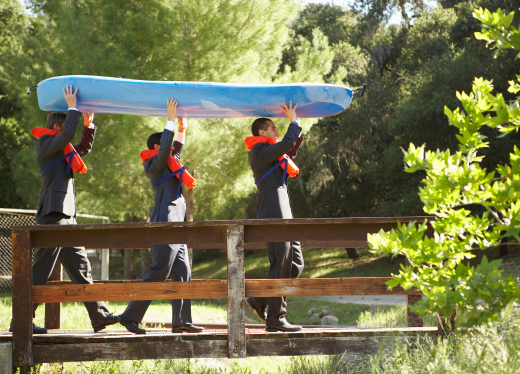It may seem like an impossible task to transport your kayak without a roof rack but there’s actually a variety of ways in which to do it.
Roof racks can be expensive, take time to install, and aren’t that easy to remove when you aren’t able to kayak for a while. You should be able to get your kayak from point A to point B without too much of a problem with the solutions provided below.
Transporting a Kayak in a Car Without a Roof Rack

Well, what’s one to do without a roof rack? For the longest time, I only had my inflatable kayak because I couldn’t invest in a real roof rack. However, over the years, I learned how to construct a DIY roof rock; but if not, there are a couple other options here to go through:
#1: Buy an Inflatable Roof Rack
Inflatable roof racks are easier to install and take off when you’re not kayaking. However, they can’t carry kayaks as heavy as the steel racks can and you have to pump them up beforehand. You must have a four-door car and it will carry one kayak. The components are included and contain anchor rings and buckles, both resistant to corrosion and rust.
#2: Do It Yourself Roof Rack
Building a do-it-yourself kayak roof rack for your car is a relatively easy and affordable way to transport your boat. With some basic supplies, you can easily build a custom roof rack that fits your car’s make and model.
Before beginning, there are a few things to consider. First, you’ll need to measure the length of your kayak in order to determine the size of the roof rack needed. This will also help you decide how many crossbars and supports you’ll need. Additionally, consider the weight of your boat when selecting materials for your roof rack.
Next, gather the necessary supplies. A few common items that can be used to construct a roof rack include: screws or nails, rope or bungee cords, drill bits, drill machine, and paint or sealant (for protection against weather). If desired, you can also purchase pre-cut pieces such as crossbars from your local home improvement store.
#3. Put It In The Backseat
If you don’t want to buy any special equipment for transporting your kayak, there’s the option of putting it in the back seat of your car or SUV.
Just make sure to strap it down with bungee cords or other straps, and make sure it doesn’t block your view of traffic or pose a danger to others. It would have to be a smaller kayak or if you have a inflatable or folding kayak, you can just put that back there without holding it down.
#4. Use Car Trailer
For those who can’t transport their kayaks on top of their car, there’s always the choice of using a trailer that comes with a hitch ball mount. If you don’t want to purchase a trailer, you can use a utility trailer that you already have and modify it for this purpose.
Check to see if there’s rules in your state for registering your trailer. Also consider that if there are no rules for it in your state, there could be rules in another state if you wanted to cross state lines with your kayak.
Alternatives to Using Your Car
If you don’t have access to a car, there are still some ways to get your kayak from point A to point B, hopefully point B being a very serene lake or a scenic river. Let’s consider other options:
#1. Load It Into The Back Of A Pickup Truck
Call up a friend who is generous and owns a truck 😉
It should be fairly simple to transport your kayak on a pickup truck but you should take the necessary precautions first. You should measure the size of your kayak to compare it with the bed size of your truck just to make sure there will be enough room for it before you start loading it on.
Also, make a note of how high your truck is and how much extra effort will be involved if you have to lift the kayak high. You won’t be able to do much with pulled muscles, so be careful with this step.
You can purchase foam blocks to go underneath the kayak so that it doesn’t move around and get damaged on the way to your destination. Make sure it’s not heavier on one side of the truck to avoid any kind of trouble down the road.
If you don’t have any foam blocks, make sure to tie your kayak down with straps or bungee cords. You’ll also want to use a truck where the back door folds down so that you can load and unload the kayak easily. Drive cautiously, avoid sudden turns, and don’t brake too fast to avoid some serious damage to both the kayak and the truck.
I think trucks are even better for kayak transportation than cars because they can carry heavy items easily and you can also take extra equipment and supplies with you.
#2. Load Your Kayak on Your Bike Trailer
You can pull your kayak along with you while you’re biking to your destination with a bike trailer.
The most popular one used is called the Dumb Stick, made of a material that is strong and won’t rust. It attaches to your bike right under the seat and extends out to lift up the front of the kayak that’s on a portage cart.
It only weighs 3 pounds, so the bar itself won’t add a lot of weight and drag when you’re pedaling around.
#3. Carry It Yourself

There’s always the option of carrying your kayak to the water if you’re close enough already or you can drive to get close enough, depending on the weight of it and your physical fitness level.
The best kayak for this occasion, especially if you can’t lift too much weight, would be an inflatable one that can fit in a backpack.
There’s also the folding kayaks like Oru and Tucktec, each made with thin sheets of plastic. They can be folded into backpacks or sacks with straps to hold them on your shoulder. There are others made of different materials, but they are also heavier, so you’ll need to take that into consideration.
Why You Might Want to Use These Alternatives Instead of a Roof Rack
Depending on the quality, metal roof racks can cost up to $750 or higher. They can also be hard to install and to see which one is compatible with your car. They are a more permanent fixture because they’re more time-consuming to remove when you’re not using your kayak.
Final Thoughts
I’ve discussed all the options you have to transport your kayak without a roof rack! You can also consider other alternatives (like using a truck or your bike) which should save you tons of money.
These are the alternatives to roof racks for transporting your kayak, from using a backpack to putting your kayak on a car trailer or truck. It all depends on how many kayaks you need to transport at one time, how much you want to spend, and how easy it would be to transport the boats with these methods.
